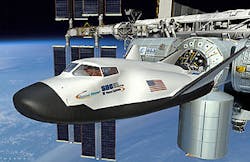The Dream Chaser space system by Sierra Nevada passes preliminary design review
LOUISVILLE, Colo., 8 June 2012. Sierra Nevada Corp.'s (SNC) Dream Chaser Space System (DCSS) has completed its preliminary design review (PDR). This review was the third major system-level review for the DCSS as part of NASA's commercial crew development round 2 (CCDev2) program.
SNC's PDR included a review of all major elements of its orbital flight program including the Dream Chaser orbital crew vehicle, the Atlas V launch vehicle, and Dream Chaser mission and ground systems. The entire design, architecture and performance of the Dream Chaser Space System was reviewed and evaluated by NASA and the DCSS partner companies. It was determined that the SNC preliminary design for DCSS is complete.
The Program's PDR came during the same week when the Dream Chaser vehicle began its flight test program, illustrating SNC's approach of concurrent design and development. On May 29, the Dream Chaser Program completed the successful first flight of Dream Chaser full scale vehicle. The flight met all the pre-established flight test goals and is a moving towards preparing the vehicle for an autonomous approach and landing test scheduled for later this summer.
The Dream Chaser is a crewed suborbital and orbital vertical-takeoff, horizontal landing lifting-body space plane that was developed by SpaceDev, a subsidiary of SNC. The Dream Chaser is designed to carry seven people to and from low earth orbit. The vehicle is designed to be launched vertically on an Atlas V rocket and land horizontally on conventional runways.
The Dream Chaser was publicly announced in September of 2004 as a candidate for the NASA vision for space exploration, and then for the commercial orbital transportation services program. The DCSS is being developed as part of NASA's venture into commercially provided crew transport.

